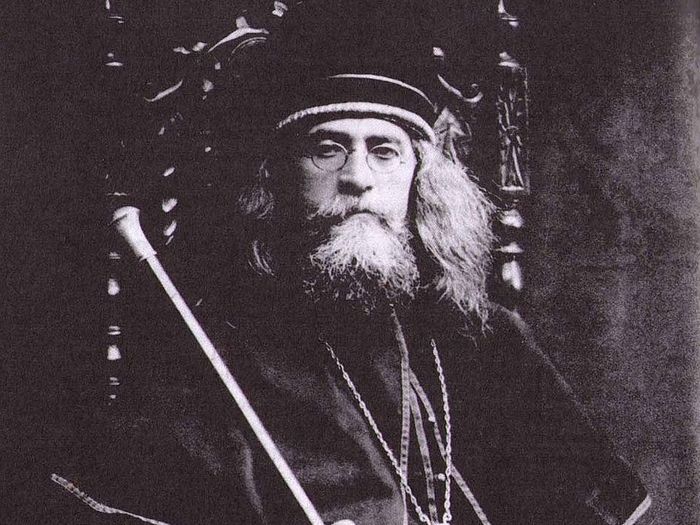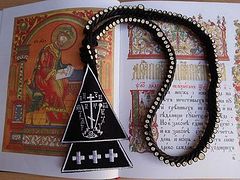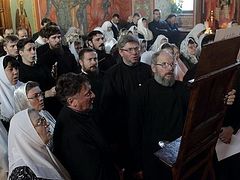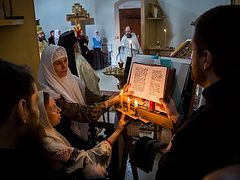History will not forget you,
dear Fr. Simeon Ivanovich!
Your name will be marked in large letters
on its impartial pages.
(From an address of thanksgiving of the delegates of the Second All-Russian
Congress of the Orthodox Old Believers [Edinoverie] to Archpriest Simeon Shleev)
On the evening of August 18, 1921, the eve of the feast of the Transfiguration of the Lord, the life of the first Edinoverie bishop, Simon (Shleev), was tragically cut short. Vladyka grew up in an Old Believer family and dedicated his entire life to serving Christ, to healing the deep wounds of the Russian schism of the seventeenth century, and to defending the rights of the canonical part of the Russian Church known as the Edinoverie. It is symbolic that Vladyka received his martyric crown heading the Ufa Diocese, having become a good shepherd for all the Orthodox Christians entrusted to him by the diocese during his short time there.
The future saint was born in the family of the Old Believer peasant Ivan Shleev in the Alatyr District of the Simbirsk Governorate on April 20, 1873. Three years later the family reunited with the Church, and Ivan became a priest in the Holy Trinity Edinoverie Church in their home village of Yavlei. Undoubtedly, his father’s ministry, the strictness of his upbringing, and the rigorous observance of the rules of Church life were decisive for the future clergyman. From the Shleev family, renowned for its high level of piety, there came several priests, scattered to various parts of Russia in their ministries.
With the blessing of his father, the God-fearing Simeon grew up and entered the Lyskovo Theological School. When he finished in 1889, his thirst for knowledge of God led the Shleev youth to study first in the Nizhny Novgorod Seminary, and then he graduated from the Kazan Theological Academy as a candidate of theology. There, in Kazan, Simeon got married. The future bishop defended his dissertation on the theme, “Edinoverie: Its Essence and Structure.” It was in Kazan that the young Simeon met with then-Archimandrite Anthony (Khrapovitsky), an outstanding ecclesiastical figure of the twentieth to twenty-first centuries. From the moment they met until his forced departure from the Russian land, Metropolitan Anthony and Bishop Simon maintained a strong spiritual connection, thanks to which many fruits were brought forth from the whole of the Edinoverie.
There, in Kazan, St. Simon, already ordained as a priest, published his first book, The Edinoverie and Its Hundred-Year-Old Organized Existence in the Russian Church. The main point that Shleev tried to bring to the reader became the thesis of the identity of Edinoverie Orthodoxy. In Kazan, Fr. Simeon was sent to serve in the Church of the Four Evangelists, and under the patronage of Archimandrite Anthony, the young priest would visit the Old Believers of the Kazan and Ufa Dioceses, entering into religious disputes with them. Undoubtedly, some were reunited with the Church as a result.
His ministry “without borders” ended with the coming of Archbishop Dimitry (Kovalnitsky) to the Kazan Diocese. The hierarch did not understand the ancient Church rite and looked upon Fr. Shleev with distrust and suspicion, calling him the new Avvakum1 behind his back. “This archbishop… never saw real Edinovertsi before his archepiscopacy. He considered them schismatics… He looked at the Edinoverie like Catholics do the Unia,” Fr. Simeon wrote in his memoirs. At that time, Fr. Simeon received an invitation to serve in St. Petersburg, which he did not fail to take advantage of. With bitter pain, the Kazan Edinovertsi released their batiushka, who had zealously served in the Church of the Four Evangelists. However, Fr. Simeon was certain that he could achieve more benefits for all Edinovertsi in the imperial capital. And he was right.
In 1905, after moving to St. Petersburg, Fr. Simeon became the rector of the Edinoverie Church of St. Nicholas. A long and bright period of Fr. Simeon’s ministry began there. Just two months later, on April 19, the decree, “On Strengthening the Foundations of Religious Tolerance” signed by the Tsar was issued. For the Edinovertsi, such an event gave the hope of getting their own likeminded bishops and was a true Paschal joy. From the time of its origin, from the end of the eighteenth century, the Edinovertsi raised the fundamental question about the need to have their own bishops in the bosom of the Mother Church. A Edinovertsi bishop would certainly understand the problems of the Edinovertsi and Old Believers who are in schism more deeply, himself living the “old” life, prayed, and organized his existence in accordance with “covenants of holy antiquity.” From the very beginning, the Edinoverie was a movement of reunification, though it did not tolerate rudeness and chancellery measures, but strove to preserve its distinctiveness. Of course, this required fervent Edinovertsi bishops who understood all the problems of the flock thoroughly.
After the issuing of the “Decree,” Anthony (Khrapovitsky), already an archbishop at that time, offered to become a Edinoverie hierarch, if it was the will of the emperor. It didn’t happen, although at the sessions of the Sixth Division of the Pre-Conciliar Presence, where this question was examined, the view of Church dignitaries on the issue of a Edinoverie bishop and the Edinoverie as a whole was significantly changed by the efforts of Fr. Simeon Shleev.
In 1906, Fr. Simeon and another Edinoverie priest, Peter Aksenov, along with a group of laymen started publishing the journal “The Truth of Orthodoxy.” The publication was not aimed solely at Edinovertsi or Old Believers; it covered important events in public and state life, assessed them, and touched on the most pressing issues of the times. The creators of the journal saw the main task as the possibility of uniting Edinovertsi among themselves, designating a tangible center in the form of the publication. Fr. Simon repeatedly appealed to the Edinovertsi from the pages of the journal with a fervent call to awaken, not to lock themselves up within the confines of their parishes, and to revive and join the general Church life, sacredly preserving the ancient traditions. Seventy issues saw the light of day before the publication ceased to exist in 1908 for unknown reasons. 100 years later, through the labors of contemporary Edinovertsi, the “Truth of Orthodoxy” journal has experienced a second birth, becoming a unique herald of Edinoverie life in our days.
In one of his letters on the pages of the journal, in response to the attacks of the authors of the “Missionary Review” and the accusations of schism, Fr. Simeon wrote: “To be Orthodox, it is not enough to understand and teach Orthodoxy, but you must live it… We are not seeking for discord, but for the triumph of Orthodoxy, of its truth, which also shines forth in the Edinoverie… We strive for the development of the good that is laid up in the treasury of the Orthodox Old Rite, the value of which is not found in ritual observances.”
Having become the rector of St. Nicholas’ Edinoverie Church, Fr. Simeon began to work actively in a new field. He organized a brotherhood, and giving it serious tasks, it successfully achieved their realization under Fr. Simeon’s experienced guidance. A real school2 was opened at the parish, catechetical and educational work was carried out, candidates for the priesthood were prepared, and charitable assistance was provided to the poor. Fr. Simeon took care for the preservation of the Church’s life and the earnest celebration of the services as prescribed. By 1914, more than 400 people were studying at the school headed by Fr. Simeon, and a girls’ school was opened.
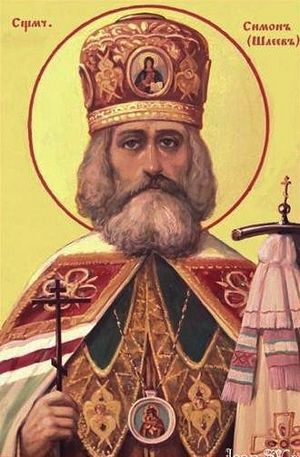 In 1910, Fr. Simeon published the book, The Edinoverie in its Internal Development. The work was the first of its kind, as few people had studied the topic before this holy hierarch did. The Edinoverie, finally, was shown not as a temporary institution, but as a valuable part of Orthodoxy, called to the holy mission of the unity of the Russian people in a spirit of brotherly love for one another.
In 1910, Fr. Simeon published the book, The Edinoverie in its Internal Development. The work was the first of its kind, as few people had studied the topic before this holy hierarch did. The Edinoverie, finally, was shown not as a temporary institution, but as a valuable part of Orthodoxy, called to the holy mission of the unity of the Russian people in a spirit of brotherly love for one another.
In 1916, Fr. Simeon’s wife died, and he took monastic vows with the name Simon. He still had a ten-year-old daughter who would accompany her father until his final days.
Fr. Simon’s activities over the course of several years led to the possibility of convening the first All-Russian Edinoverie Congress. Delegates came from every corner of the Russian Empire, and the Edinoverie finally had the chance to discuss a number of accumulated questions. Of course, they were first of all devoted to appointing a bishop. This had been a crucial issue for the Edinoverie from the moment of the organization of this God-pleasing institution, but it had never sounded so powerfully and so organized before. “The questions of the first… Congress… were mainly about a Edinoverie bishop, about the oaths of the councils… They are as old as the Edinoverie itself,” Fr. Simon later wrote in the preface to the words of the Congress. The delegates of the Congress warmly thanked Fr. Simon for his labors, for his desire to work for his native Edinoverie and the entire Church. Five years passed and the second Congress was held, the result of which was the election of Fr. Simon, who had become an archimandrite by that time, as bishop. Batiushka repeatedly rejected the nomination, but the fervent pleas of the Edinovertsi did their job. On June 16, 1918, Patriarch Tikhon of Moscow and All Rus’ elevated Archimandrite Simon to the rank of Bishop of Okhten, celebrating the consecration according to the old books in the Holy Trinity Cathedral of the St. Alexander Nevsky Lavra.
In his deep humility, Vladyka Simon, probably dreaming of having a bishop for the Edinoverie more than anyone else, sought this for himself least of all. Batiushka believed there were many who were more worthy than him. And the fate of the Edinoverie bishop did not promise a quiet and full life. He was entrusted with the care of a flock spread over a vast territory; one trip followed another, and he had to delve into the issues of dioceses that had completely different states of internal affairs… The saint loved God, and therefore he loved the services—not as a mechanical act, a “legalistic” execution of statutory instructions, but as an expression of sincere love for the Trinity. A Christian is saved “through the narrow gate,” and Vladyka Simon loved the monastic way of life, which was intrinsic in the laity for many centuries in ancient Rus’. He believed that a weakening, a retreat from the services—“the clothing of dogma”—would inevitably lead to the impoverishment of the faith. It was likely the fervor with which he so zealously defended the rights of the Edinoverie that led to his unanimous election as bishop.
St. Simon was elevated to the rank of bishop during the time of triumphant atheism. In 1920, by decree of Patriarch Tikhon, Bishop Simon took up the See of Ufa. Several waves of civil war swept through the diocese, and the heavy work of restoring parish life, which in many parishes had simply frozen, was laid upon his shoulders. It required new priestly ordinations and the active preaching of the word of God, which Vladyka was actively engaged in.
There, in Ufa, Vlaydka finished his earthly journey. Bishop Simon enjoyed great respect at his new place of ministry. The faithful immediately loved him. Vladyka was very accessible for communication, and very kind, simple, and selfless. He gave away everything he had, taking no thought for the morrow. The strength of his spirit helped him to negotiate with the soviet authorities in difficult times and intercede for those who came under trial, whether for religious or political reasons.
Vladyka’s authority played its role: The local Cheka feared to openly eliminate the holy hierarch. Instead, a villainous combination of murder and a staged robbery was set in motion. On the eve of the feast of the Transfiguration of the Lord, Bishop Simon (Shleev) was shot in his yard…
St. Simon devoted the half-century of his short but bright life to the cause of the Edinoverie—the preservation of genuine Church life from secularization, and the healing of the grievous wound of schism. No one before or after did so much in this matter as Vladyka Simon was able to do with the help of God. The Edinoverie became a full-fledged institution in the Russian Church; its internal life was put in order, and for the first time from the moment of the schism, bishops appeared, consecrated according to the old books. The legacy of ancient Rus’, expressed in the high spirit of the services according to the typicon, the Znamenny chanting, the canonical iconography, the preservation of ancient traditions, and the ecclesiastical existence and way of life, was preserved and multiplied and became the property of the entire Church by the efforts of Bishop Simon. And how many Old Believers returned to the bosom of the Mother Church!
This brief work is a modest attempt in broad strokes to draw the attention of a wide circle of the Orthodox community to the personality of the Holy Hierarch Simon. Born in a schismatic Old Believer family and having become a figure in the Edinoverie—a unification movement, a peacemaking movement—the holy hierarch’s life ended martyrically in an Orthodox diocese, and he joined the hosts of New Martyrs and Confessors of the Russian Church.

